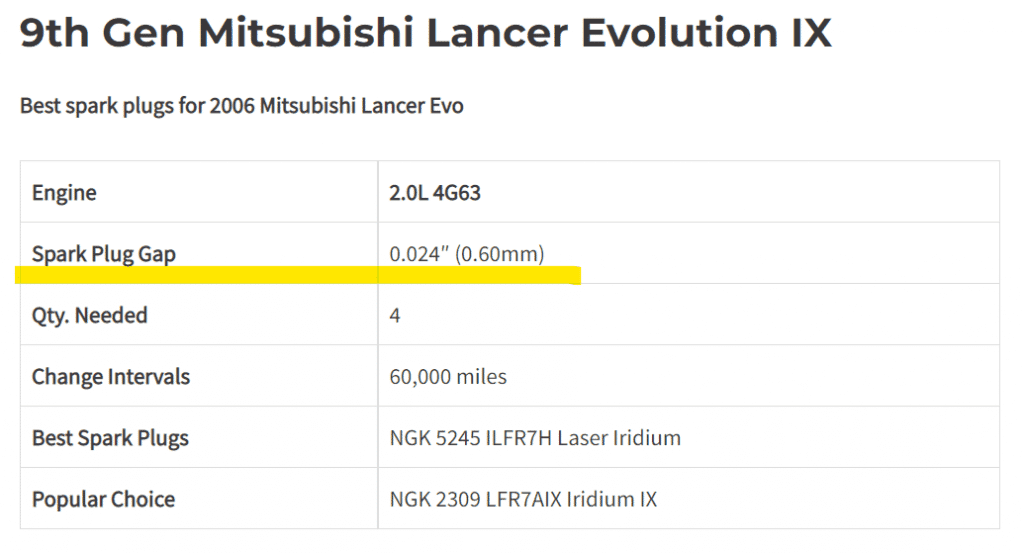If you’re like most drivers, you probably don’t think about your spark plugs until they start to cause problems. And by then, it’s often too late. Spark plugs that are overdue for a tune-up can lead to all sorts of engine problems, such as misfiring, poor gas mileage, and decreased performance. That’s why it’s important to know how to gap spark plugs correctly so you can avoid these issues and keep your car running smoothly. This article will teach you how to gap spark plugs like a pro!

How Does Spark Plug Gap Affect Performance?
The gap setting on a spark plug is the distance between the electrode and the tip of the spark plug. This gap determines how much voltage is required to jump across the gap and create a spark. If the gap is too small, the spark will be weak and might not ignite the air/fuel mixture correctly. On the other hand, if the gap is too large, the spark will be too strong and can cause damage to the engine. That’s why it’s important to set the correct gap for your vehicle.
A large spark plug gap setting requires a higher voltage to jump the distance between the electrodes. This is because there is a higher voltage build-up in the ignition system prior to spark discharge. In general, this effect is desired in applications with late-model high output ignition coils and lower compression naturally aspirated engine applications where cylinder pressures are relatively low, and it’s easy for the spark to discharge.
What Is A Spark Plug Gap Feeler Gauge?
A spark plug gap feeler gauge is a simple tool that helps you measure the gap between the electrodes on a spark plug. You can find these gauges at most auto parts stores or online.
How To Measure Spark Plug Gap?
The majority of engines will have their spark plugs gapped at .028-.045 inches. Some newer cars with turbocharged or high-performance engines might have a larger gap .055 inches. It is important to check your owner’s manual to see what the manufacturer recommends for your specific vehicle.
You can measure the gap in two ways: with a feeler gauge or a micrometer. A feeler gauge is the most common way because it is quick and easy. All you need is a feeler gauge, which consists of a handle with several thin metal strips, called blades, of different thicknesses that are used to measure gap settings.
Spark Plug Gap Cross Reference Chart (mm to inch)
| MM | INCH |
| 0.40 | .016″ |
| 0.50 | .020″ |
| 0.60 | .024″ |
| 0.70 | .028″ |
| 0.80 | .032″ |
| 0.88 | .035″ |
| 0.99 | .039″ |
| 1.11 | .044″ |
| 1.40 | .055″ |
| 1.50 | .059″ |
| 1.60 | .063″ |
| 1.70 | .067″ |
How to Gap Spark Plugs
There are two ways to gap spark plugs: a feeler gauge, spark plug gapper, or a tool called a micrometer. We’ll show you how to do both methods so you can choose the best option.
Using a Feeler Gauge
This is the most common way to gap spark plugs because it’s quick and easy. All you need is a feeler gauge, which is a tool that consists of a handle with a bunch of thin metal strips called blades. Each blade has a different thickness, which is how they’re used to measure gap settings.
To use a feeler gauge, start by selecting the correct blade size for your vehicle (consult your owner’s manual or repair manual to find out what size you need). Then insert the blade into the gap and see how much resistance you feel. If the blade slides through easily, that means the gap is large, and you need to make it smaller. If the blade doesn’t fit or is very difficult to insert, that means the gap is too small, and you need to make it larger. To adjust the gap, gently bend the side electrode until you achieve the correct setting.
The most essential rule while checking or adjusting the spark plug gap is that you should never pry, apply, or apply any force to the center electrode ceramic insulator of the spark plug. The force should be applied only to the ground strap of the spark plug, which may be moved closer or further away from the spark plug center electrode.
The spark plug gap should not be adjusted more than three times and should not exceed.008″ in either direction. If the spark plug gap is excessively altered, the ground electrode of the spark plugs will weaken, failing. Furthermore, the spark plug gap should never exceed .055″ unless pre-set by the manufacturer.
Using a Micrometer
A micrometer is a more precise way to measure spark plug gap settings. This tool consists of a handle with a rotating barrel that has markings in thousandths of an inch. To use a micrometer, start by zeroing out the tool, so the measurement starts at 0. Then insert the micrometer into the gap and rotate the barrel until it comes in contact with both electrodes. The gap measurement is the number that lines up with the indicator on the handle.
If the gap is too small, you can use a spark plug gap file to enlarge it. If the gap is too large, you’ll need to use a feeler gauge to reduce it. Once you’ve achieved the correct setting, gently tighten the spark plug, so it doesn’t move when you remove the micrometer.
It’s important to note that some spark plugs have what’s called a tapered seat. This means that the ground electrode tapers down to meet the side electrode at an angle, and this type of spark plug doesn’t require gapping. You can tell if your spark plugs have a tapered seat by looking at the end of the ground electrode—if it isn’t flat, then it’s tapered.
As long as you’re careful and take your time, gapping your spark plugs is a relatively simple process. By taking the time to ensure that your spark plugs are properly gapped, you can help optimize your vehicle’s performance and fuel efficiency. Plus, it’ll save you money in the long run by helping to prevent engine damage. So don’t be afraid to gap those spark plugs! Your car will thank you for it.
How To Gap Iridium Spark Plugs?
Iridium spark plugs have a much smaller electrode tip than traditional spark plugs, so they require special care when gapping. The best way to gap iridium spark plugs is with a feeler gauge.
What Are The Main Issues With Spark Plug Gap Settings?
If the spark plug gap is too small, it can cause the engine to misfire. If the gap is too large, it can cause the spark plugs to overheat. It’s important to consult your owner’s manual or repair manual to find out what the correct gap setting is for your vehicle.
Over time, erosion causes the gap between a plug’s tip and hook to widen. To make plugs last longer, mechanics usually set the gap at the engine manufacturer’s minimum recommended rather than in the middle of what is acceptable.
A bigger gap, on the other hand, creates a “hotter” or “thicker” spark and helps to ensure that the fuel-air mixture is ignited. Furthermore, a new plug with edges on the center electrode will spark more consistently than an old, eroded plug. As a result, seasoned mechanics understand that the maximum gap specified by the engine manufacturer is also the widest gap that will spark reliably even with worn plugs and will be somewhat narrower than required with new plugs.
In other words, you can space the plugs far apart to ensure ignition in high-powered applications, but then you’d have to replace or regap the plugs more regularly as soon as the tips start wearing down.
What Happens If I Don’t Gap My Spark Plugs?
If you don’t gap your spark plugs, it can lead to engine damage and decreased performance. Additionally, your fuel efficiency will suffer, and you may notice that your car doesn’t start as easily as it used to. In short, it’s not worth skipping this crucial step!
How To Gap Spark Plugs Without Tool?
If you don’t have a tool to gap your spark plugs, you can use a coin. First, find a coin that is about the same thickness as the desired gap setting. Next, insert the coin between the electrodes and gently twist it until it’s tight. Finally, remove the coin and check the gap to see if it’s been properly set.
For your reference, a penny is 0.06” while a dime is 0.053”. If your recommended gap size differs from these two coins, you probably need to get a spark plug gap gauge or gapping tool.
It’s important to be careful when using this method, as it’s easy to accidentally make the gap too large or too small. If possible, it’s always best to use a proper gapping tool.
What Is The Proper Gap Setting For My Vehicle?
The proper gap setting for your vehicle can be found on our website. Just use our catalog to navigate to your car’s page. The selected page will provide you with all the info you need. Proper gap setting can be founded in the table.

When in doubt, it’s always best to stand on the side of a smaller gap. A smaller gap will help prevent engine damage, and it’s easier to adjust a small gap than it is to adjust a large one.
Conclusion
As you can see, there are a few different ways to go about gapping your spark plugs. No matter which method you choose, just be sure to consult your owner’s manual or repair manual to find out what the correct gap setting is for your vehicle. And always be careful when adjusting the gap, as it’s easy to accidentally make it too large or too small.
If you have any questions about how to properly gap your spark plugs, feel free to reach out to us. We’d be happy to help!